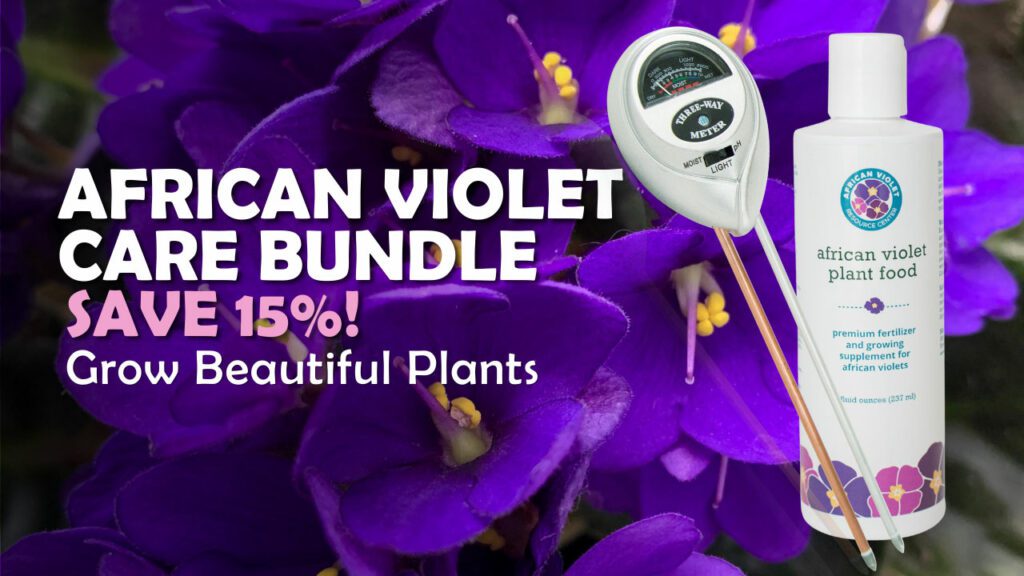African violets are one of the most popular houseplants in the world, due largely in part to their eye-catching foliage. This makes it extra stressful when their usually vibrant, dark-green leaves begin to droop and dull. Sudden leaf changes are an SOS signal from your plant, but it’s up to you to determine the underlying issue.
This post unpacks three common culprits and cures and for an African violet with droopy leaves. Let’s dive in!
1. African violet leaves are droopy, soft, and mushy
Likely Culprit: Overwatering
Overwatering is one of the most common causes of droopy African violet leaves. That’s because their delicate root systems can’t handle waterlogged soil. Prolonged overwatering can suffocate your plant, causing a life-threatening disease called root rot.
How to tell if your African violet is overwatered
Droopy, soft, and mushy leaves are telltale symptoms your plant is suffering from too much water. These additional signs can help confirm overwatering is the source of your plant’s struggles.
- Wet soil: Damp soil indicates there is more moisture in the soil than your plant can soak up, or the soil is too dense for its roots to properly absorb water.
- Inhibited growth: Your plant may drop its leaves, grow more slowly, or stop growing altogether if overwatered.
- Root rot: Above ground, root rot causes leaves to yellow and drop. Below the soil, you’ll find that portions of the root have turned black and soggy.
How to fix an African violet with droopy leaves from overwatering
- First, trim off any dead, droopy, or mushy foliage. These leaves won’t recover; removing them frees up energy for your plant to heal.
- Next, remove your African violet from its pot and gently brush the soil from the roots. Remove any black or mushy root segments and apply root rot treatment if the damage is severe.
- Repot using specialty African violet potting mix. Conventional potting mix is too dense for your plant’s delicate roots.
- If you removed a substantial portion of the root system, repot in a smaller container, as African violets prefer to be slightly root-bound.
2. African violet leaves are curling downwards, droopy, and dull
Likely Culprit: Underwatering
On the flip side, underwatering can also result in an African violet with droopy leaves. A prolonged lack of moisture can deprive your plant of the hydration it needs to maintain firm, healthy foliage. Instead, thirsty leaves will turn dull and wilty.
How to tell if your African violet is underwatered
If your African violet’s droopy leaves are accompanied by the following symptoms, it is probably suffering from underwatering:
- Frail foliage: Lack of water will cause your African violet’s vibrant green leaves to crisp, dull, and curl inward.
- Dry soil: Bone-dry, crumbly soil indicates your plant has depleted all the available moisture from its environment.
- Soil gap: Water causes soil to expand and take up more space. Extremely dry soil will shrink in size and pull away from the sides of the pot.
- Light pot: If your pot is unusually light, this indicates a complete absence of water from the soil.
How to fix an African violet with droopy leaves from underwatering
If you catch it soon enough, underwatering is an easy fix: give your plant a good stiff drink! But don’t overcompensate by repeatedly drenching your plant. Rather than quenching its thirst, overwatering will take your already vulnerable African violet from dry to drowned in a hurry.
Try This: We recommend bottom-watering African violets. This technique allows your plant to take up exactly as much water as it needs, and not a drop more—or less! Our guide to African violet watering outlines our favorite methods.
3. African violet leaves are turning yellow, droopy, and crowding together
Likely Culprit: Too much sunlight
While some plants love soaking up the sun, your African violet isn’t one of them. These tropical flowers evolved under the jungle canopy and thrive in diffused sunlight. Direct light is simply too harsh for their delicate leaves, and can quickly cause visible damage
How to tell if your African violet is getting too much sun
In addition to droopy leaves, here’s how to confirm your plant is not having fun in the sun:
- Damaged foliage: African violet leaves will turn yellow, crisp, and curl inward around the edges if overexposed to sunlight.
- Leaf scorch: Just like you, African violets will sunburn without proper protection from UV rays. This is called sun scorch, which shows up as brown burn spots on the leaves.
- Failing flowers: If your plant is stressed out by too much sunlight, its flowers may turn brown and crispy or drop altogether.
How to fix an African violet with droopy leaves from too much sunlight
Just like you, the best remedy for a sun-scorched African violet is shade! African violets prefer indirect light in well-lit spaces. This means no sunny windowsills or bright countertops. If you can see a strong shadow when you place your hand between your plant and the sun, move it somewhere dimmer.
Perfect Placement: Our handy guide to African violets and sunlight will help you find the bright that’s just right for year-round blooms.
Other causes of an African violet with droopy leaves
Excessive Heat
Too much heat can cause African violet leaves to droop and turn brown and crispy. If your plant shows these signs, appears weak, and seems as if it may topple over, reconsider where you’ve placed it. The best place to keep your African violet is somewhere that maintains a steady 68-70ºF for most of the day.
Lack of Heat
Excessive cold air can cause African violet leaves to droop and shrink up. Avoid cold winter windows or places where the temperature frequently swings (like drafty entryways). Your plant’s preference for pleasant temperatures applies to water too! Always use room-temperature water, rather than cold water, at bathtime to avoid shocking your plant’s delicate roots.
Overfertilization
If you see white crystals built up in the soil, paired with droopy leaves, your African violet may be struggling from fertilizer buildup. Flush the soil thoroughly (while being mindful to keep the leaves dry) to remove excess salts. Once your plant begins to grow again, resume fertilizing at half strength.
Does your droopy African violet have symptoms we didn’t touch on? Join the conversation in our Facebook group.
Join the African Violet Club!
Whether you’re just starting out or are a seasoned grower, African Violet Resource Center has everything you need to help your plant grow vibrant and strong. Explore our other articles, visit our online shop, and connect with other houseplant lovers in our Facebook group to learn everything you need to know about this rewarding hobby!
More Great African Violet Resources
Top African Violet Instagram Accounts
Everything You Need to Know About African Violet Leaves







